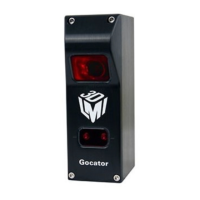Gocator Line Profile Sensors: User Manual
How Gocator Works • 62
Measurement and Anchoring
After Gocator scans a target and, optionally, further processes the data, the sensor is ready to take
measurements on the scan data.
Gocator provides several measurement tools, each of which provides a set of individual measurements,
giving you dozens of measurements ideal for a wide variety of applications to choose from. The
configured measurements start returning pass/fail decisions, as well as the actual measured values,
which are then sent over the enabled output channels to control devices such as PLCs, which can in turn
control ejection or sorting mechanisms. (For more information on measurements and configuring
measurements, see Measurement on page 180.)
You can create custom measurement tools that run your own algorithms. For more information,
see GDK on page 544.
A part's position can vary on a transport system. To compensate for this variation, Gocator can anchor a
measurement to the positional measurement (X, Y, or Z) or Z angle of an easily detectable feature, such
as the edge of a part. The calculated offset between the two ensures that the anchored measurement
will always be properly positioned on different parts.
If combined with the matching and rotation capabilities of part matching, anchoring accounts for most
sources of variation in part position and orientation and, consequently, avoids many measurement
errors. For more information on anchoring, see Measurement Anchoring on page 194.
Output and Digital Tracking
After Gocator has scanned and measured parts, the last step in the operation flow is to output the
results and/or measurements.
One of the main functions of Gocator sensors is to produce pass/fail decisions, and then control
something based on that decision. Typically, this involves rejecting a part through an eject gate, but it can
